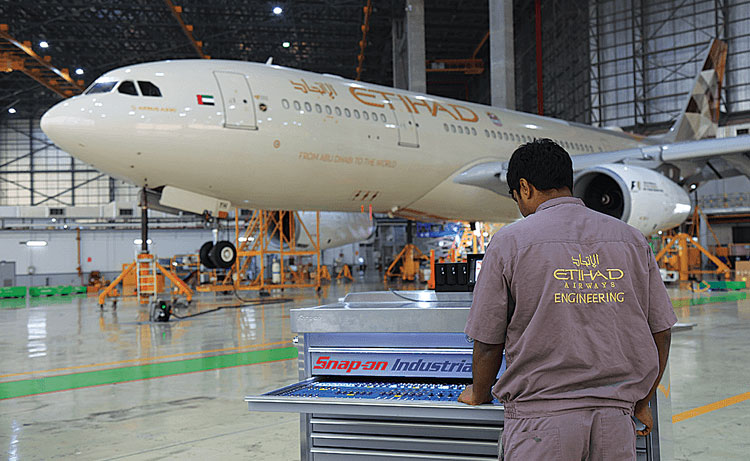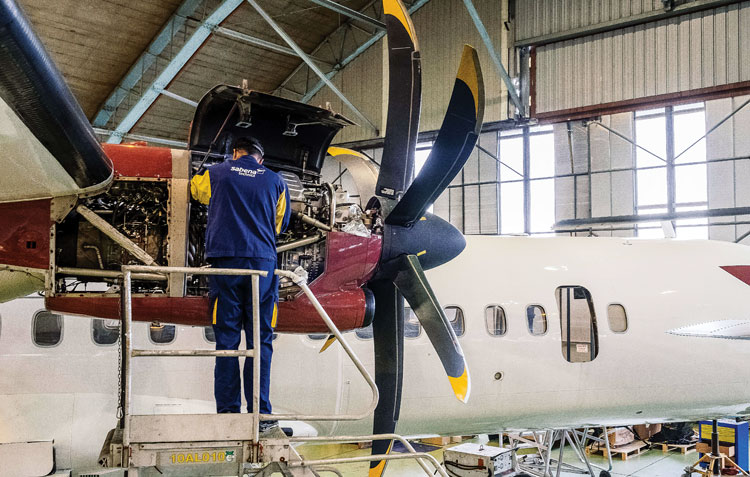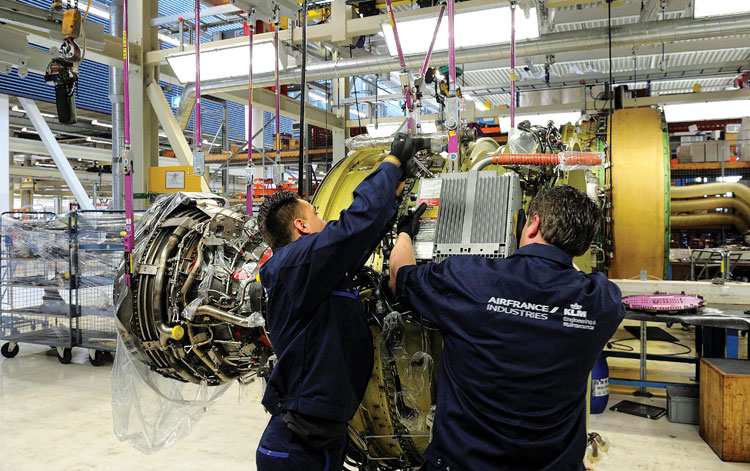Global MRO Industry
A prudent, proactive, conciliatory and creative conglomeration between the aviation OEMs, airlines, MRO companies, logisticians and computer programmers, can help tide over the COVID-19 crisis

Aircraft are complex flying machines that have numerous static or moving components and sub-assemblies. The operational life of each of these is different. Hence, the Mean Time Between Failure varies substantially amongst them. Thus, to keep an aircraft airworthy, multiple maintenance activities are required. These are called as Maintenance, Repair and Overhaul (MRO) activities. They include work that could be scheduled, preventive or any major refurbishments. All these activities are undertaken to restore aircraft to nearly its original condition.
The MRO activities require skilled and certified technicians, spares and test rigs. These resources are expensive. Airlines find it economically unviable to invest in this activity and prefer to outsource maintenance to specialist MRO companies. The COVID-19 pandemic forced MRO companies to reduce skilled manpower to reduce costs. It disrupted spares supply chain and has been a major MRO business disrupter. However, as the COVID-19 restrictions are being eased out, demand for air travel is picking up and the scheduled MRO activities that were held in abeyance by the aircraft operators will commence.
MRO TRENDS
The Federal Aviation Administration (FAA) of the United States (US), in its recent report has articulated that during the year 2019, the US had 7,628 aircraft. This is expected to rise to 9,421 by 2040. This will fuel the demand for MRO over the next two decades duly fueled by the repair effort needed for the existing ageing fleet. It is true that the period March to mid-May this year had the worst impact on the civil aviation sector. Due to the global lockdown, potential fliers became immobile. Consequently, airlines that used to depend on the MRO hub for scheduled overhaul could no longer do so because of the lack of demand for passenger flights. Hence, either the aircraft had to fly to the hubs by bearing the flying costs or they had to choose to defer MRO needs altogether. In the latter scenario, the MRO needs were merely postponed; but not eliminated. This either raised the bottom lines of airlines or lowered the top lines of the MRO and Original Equipment Manufacturers (OEMs). Consequently, the smaller MRO companies had to shed technical manpower.

It is evident that as flights such as Vande Bharat services opened up, more and more aircraft are taking to the skies. Cargo planes have not faced much grounding. Hence, there is an active and latent demand for MRO services which will invariably increase in the coming months.
CHALLENGES AHEAD
Lack of skilled manpower is the greatest challenge in the MRO sector. This is due to the fact that MRO companies chose to release their trained manpower to conserve their capital as revenues depleted in the absence of demand. With manpower having drifted to other sectors for their livelihood, these MRO service providers are now finding it difficult to muster technicians.
The sudden imposition of restrictions due to the pandemic resulted in aviation spares and consumables getting stuck up at various stages of the logistics supply lines. This made it difficult to implement the ‘Just-In-Time’ concept of supply chain management. As a result, the logistics cost rises. Since the staff has been reduced, those who operated the supply chains through automation, find it difficult to track the spares location on a real time basis. This raises the MRO costs as the aircraft and technicians sit idle awaiting spares for a job at hand.
The global predictions for the MRO industry have definitely been affected by the pandemic
In order to create additional revenues streams, the OEMs have started entering the after-sales maintenance markets. Usually, the post-sale repairs were left to the MRO companies. However, recently, the OEMs, especially those that hold Intellectual Property Rights (IPR) to their products, components, processes or assemblies, have entered the fray to take on the MRO services for their products themselves. Consequently, due to legal and technical barriers, there is a distinct shift of earnings from the MRO companies to the IPR holding OEMs. This will increase the cost of MRO as MRO activities are now being undertaken by more than one organisation.
Many a time, the MRO companies may themselves not have skilled manpower the necessary tools or authorisation to execute certain MRO tasks. In such cases, they would be outsourcing such tasks to third-party vendors. This is where the quality of work can become questionable. Ethically speaking, the MRO company should inform the customer about their plan to outsource part of the MRO activity but this is seldom done. The customer selects the MRO service provider based on quality of work, but a third-party vendor may not deliver the same quality. Hence this is where a deficiency of service may arise.

Inventory holding costs for spares can be high for the MRO companies. This is because they have to first buy, sort and store components based on anticipated demand which may not materialise. In such a case, the MRO company first has to invest in the component and the money is realised after the MRO activity is completed, approved and billed. Consequently, the MRO companies will try to pass on this investment to either the OEMs of the components or to third party stockists.
The COVID-19 pandemic forced MRO companies to reduce skilled manpower to reduce costs
An alternative but plausible, is the purchase of components from manufacturers who have been approved by the FAA, but whose components were not used by the aircraft manufacturers. This is something that the aircraft OEMs may not accept. The other option is to use second hand components that are documented, tested and stored as per FAA guidelines thus reducing inventory costs. Though this may be used by private aircraft owners, it is a less preferred option for the national carriers. Component logistics is a major concern as it affects the safety and cost of an aviation asset.
ARTIFICIAL INTELLIGENCE
The world is witnessing rapid growth of technologies involving Artificial Intelligence (AI), Robotics and analysis of Big Data. Engineers are developing software that are able to think and evolve like humans, where a computer learns from its past experience and also picks up relevant insights from the internet on its own, based on a preferred algorithm to improve its deliverables. This enables the computer to replace humans, reduce the cost of operations as well as usher in greater reliability vis-a-vis fatigue and emotion-related human error.

Several aircraft manufacturers are introducing AI, Robotics and Big Data analysis to capture the prevailing health of components and sub-assemblies. This enables them to evaluate the residual operational potential of the audited equipment and reduce their maintenance costs. This step, though helpful for the large OEMs, produces an asymmetric commercial market for minor MRO players who cannot assimilate these technologies due to their financial constraints and vision constrictions. Hence, they will lose business to the larger MRO companies or to OEMs. It will be pertinent to state that every challenge is a stepping stone to an opportunity and to reap economic success.
OPPORTUNITIES
The shortage of trained manpower can be overcome by raising their compensations and retirement age for the medically fit. This will increase the pool of qualified technicians and wean them back to the aviation sector. The use of internet-based audio-visual technology can be used to get real time guidance from the master technicians while the junior staff works on MRO jobs at remote locations. This will enable the MRO companies to reduce the movement cost of technicians between various MRO hubs yet ensuring the availability of their consultancy on a real-time basis. Another possibility will be to shut down minor MRO hubs and pool the technical stores and skilled manpower at major MRO hubs to reduce costs through economy of scale. Of course, the creation of a database and available work schedules of the technicians will be of immense help to overcome labour shortages.
Several aircraft manufacturers are introducing AI, Robotics and Big Data analysis to capture the prevailing health of components and subassemblies
The shortage of spares due to their abandonment during the sudden lockdown will restart with the geo-referencing of each component along with the possession details of the same on a central database. These can then be moved by logisticians on priority or optimal basis. The transnational movement of aviation components attracts levy of interstate duty. The incentive to locally manufacture components that are FAA-approved though not manufactured by the OEM will reduce MRO costs and aircraft downtime. This provides opportunities for aviation companies to set up facilities to manufacture FAA-approved quality products and induce the local governments to encourage such indigenous growth.
Manufacturers having a proven track record of integrity will be able to provide previously used components for replacements at lower cost. This will open new jobs in sectors such as forensic analysis of pre-used components to measure their residual life vis-a-vis their documents. The MRO companies can also enter into long-term purchase-based contracts through intermediate stockists at hub centres to ensure cheaper availability of spares.
Software companies using AI and Big Data Analysis can provide MRO-related leads to smaller MRO companies about which component of which airline needs a repair through virtual data centres created by them. They may negotiate a fee-based arrangement to buy the wear-and-tear data from the OEMs and users to provide it as a service to the smaller MROs thus reducing asymmetries between MRO companies.
The global predictions for the MRO industry have definitely been affected by the pandemic. However, a prudent, proactive, conciliatory and creative conglomeration between the aviation OEMs, airlines, MRO companies, logisticians and computer programmers can help tide over the COVID-19 crisis and bring prosperity to the aviation ecosystem.





